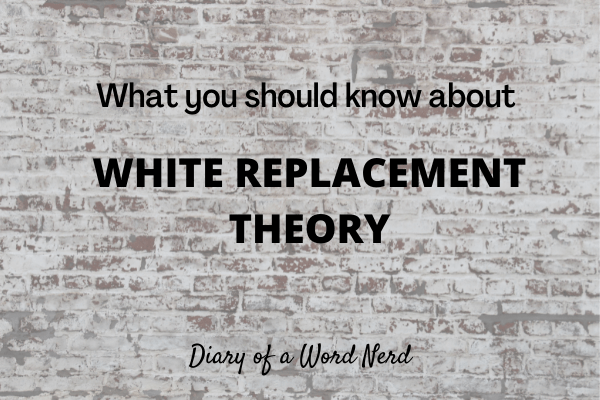As a Word Nerd, I believe it’s important to understand the words and terms we use. In my little corner of the Internet, I like to pose questions, gather information, look at nuance. Consider it a nice alternative to Twitter. This week, I’d like to take a nerdy look at a frequently used term from recent current events: The Great Replacement Theory.
What is replacement theory?
On May 14, 2022, a white 18 year old man entered a Buffalo, NY grocery store and started shooting. Eleven of his 13 victims were Black. Ten victims died. Authorities are trying to determine if a lengthy screed posted online was written by the shooter. That screed includes references to “white replacement” as well as “white genocide.”
So what do these loaded phrases mean?
According to multiple sources, replacement theory is a belief that there is an active, ongoing, and secret effort to replace white populations with non-white people in white majority countries. This effort is supposedly perpetuated by elites or globalists. Some followers of the theory accuse Jews of plotting the effort.

The term “the great replacement” was originally coined by Renaud Camus, a French man who published a book in 2010 called Le Grand Remplacement. It in, Camus asserts that Europe is being invaded by Black and Brown immigrants from Africa. His ideas sparked a far right, anti immigrant movement in Europe often called the “identitarian movement.”
Camus said he was influenced by Jean Raspail, the author of a 1973 dystopian novel The Camp of Saints in which starving third world refugees overrun Europe. The book went out of print, but in 1994, John Tanton’s publishing house, The Social Contract Press, brought it back into circulation. Tanton is considered a modern day leader of the anti-immigrant movement. He has founded several anti immigration groups in America, including Federation for American Immigration Reform (FAIR) and the Center for Immigration Studies (CIS).
The history of replacement theory
Concerns about white replacement or white extinction have been around since at least the 19th century in both America and Europe. In 1892, British/Australian author Charles Pearson cautioned his readers that white people would “wake to find ourselves elbowed and hustled, and perhaps even thrust aside by peoples whom we looked down upon.” His book National Life and Character inspired American authors to write similar books, such as The Passing of the Great Race by Madison Grant.Grant warned of the decline and extinction of America’s “Nordic” racial demographic.
Grant’s work contributed to the eugenics movement, which is “the practice or advocacy of controlled selective breeding of human populations (as by sterilization) to improve the population’s genetic composition.” (Merriam-Webster). Advocates of eugenics wanted to control reproduction to preserve “superior” races and ethnic groups.
In the early 1900s, Harry Laughlin was a leader of the eugenics movement in America. He helped design a quota system for American immigration policy that made its way into the 1924 Immigration Act signed by Calvin Coolidge. (The provisions of this act were overturned in the 1960s.) Laughlin also supported forced sterilization laws that were passed in 31 states plus D.C. and Puerto Rico. NPR reported in 2016 that 70,000 Americans, many of them women of color, were sterilized during the 20th century. Eugenics ideology spread around the world, and it permeated Nazi policies during the 1930s and 1940s. Eugenics gained notoriety later in the 20th century because of this association Nazi activities.
How replacement theory is showing itself today
Now, ideas about “white replacement” and “white genocide” fertilize the seeds sown by men like Laughlin, Grant, and Pearson. “White genocide” is a term recently coined by white supremacist leader David Lane. He wrote “The White Genocide Manifesto” while serving time in a U.S. prison for crimes he committed while active with the white supremacist terror group The Order. White genocide is also mentioned in the online screed attributed to the Buffalo shooter.
People concerned with white genocide fear that non-white immigration, mixed race families, abortion, same sex relationships, and drug and alcohol dependence will undermine White America with violence and crime.
Recent events show that not only is replacement theory still around, but also it might be gaining traction. Replacement theory, and/or white genocide, have been associated with several violent incidents from the past few years:
- At the August 2017 rally in Charlottesville, VA, marchers chanted “You will not replace us. Jews will not replace us.”
- The murder suspect in the October 2018 shooting at a Pittsburgh Synagogue cited replacement theory as motivation.
- The shooter who attacked a mosque and community center in in Christchurch, New Zealand in March 2019 cited replacement theory in his screed .
- The suspect who in 2019 fired shots in a synagogue in Poway, CA and set fire to a mosque in Escondito, CA also cited replacement theory as his motivation.
Ideologies like white replacement and white genocide are moving from extreme edges of American society into the mainstream. Tucker Carlson of Fox has talked about The Great Replacement on his show. And he is indoctrinating his audience with terminology and ideas from a replacement mindset. A study conducted by The New York Times reviewing five years of Carlson’s evening Fox show found 400 occasions when Carlson talked about Democrats actively seeking to change demographics, and therefore affect elections, via immigration policy.
Replacement ideology has been around for a while, but it seems to be getting more popular with Americans. Currently, one in three Americans believe that there is an ongoing effort to replace US born Americans, or legacy Americans, with immigrants for the purpose of electoral gain.
This is clearly an issue to keep an eye on. Many believe it has racist undertones and fuels racist violence. After doing much reading and research, I share that concern.
Learn more about replacement theory
If you are interested in learning more about replacement theory, white genocide, eugenics, or the people related to these ideologies, here are some places to start. As always, I recommend consulting multiple sources from a variety of viewpoints.
- The Southern Poverty Law Center
- What is “great replacement theory” and how does it fuel racist violence? from PBS
What do you know about replacement theory? Can you share other incidents/ articles related to it?
Thanks for getting nerdy with me!



